- Home
- Nathan Lowell
Captain's Share (Trader's Tales from the Golden Age of the Solar Clipper) Page 2
Captain's Share (Trader's Tales from the Golden Age of the Solar Clipper) Read online
Page 2
It’s funny how old habits die so hard. Almost eight stanyers since I’d been system’s officer and I still reviewed incoming traffic logs when I was on watch. Being first mate had its own load to haul but part of that load involved making sure the ship stayed safe. In the Deep Dark extra eyes sometimes meant living to get to port.
That’s how I happened to spot the HazNav notice in the incoming traffic queue. We got a fresh load of data at each jump, picking up a packet from wherever we’d been and trading it wherever we went, for updated news of the system. A few light-days out from the primary, the data on the buoy was relatively fresh and it would only get fresher as we moved inward. Usually, that incoming packet was nothing to beam home about. It held some limited price and cargo data, some news and sports scores. We had to have the sports scores. I suspected the betting pool in engineering berthing of tapping the feed directly but so long as the wagering was fair, there wasn’t any reason for me to interfere.
That particular packet carried a high priority flag and that wasn’t usual. Our current third, a competent and slightly crazy individual named Julianna Kazyanenko, scampered up the ladder to the bridge even before the packet finished its load up.
She grinned at me as she slipped into the systems’ console. “You readin’ my mail again, Ishmael?”
“That’s ‘Mr. Wang’ to you when I’m on duty, Ms. Kazyanenko!” I tried to growl and look fierce.
“And who are you when you’re ta home, then?” she shot back. She wasn’t really paying attention to me. An excellent systems and comms officer, her focus was already deep in the machine.
Mark Clemming had the helm and he stared straight ahead. I could just see his face from where I sat. I looked across the bridge to where Kaz was ripping the data packet apart to extract the HazNav notice.
“So you were reading my mail.” Her attention was still riveted on the message traffic. “It’s not far from our track.”
I’d already keyed the course plot into the big display above my own station and saw we’d be moving within a few thousand kilometers of the hazard. That was unusual enough that I sent a copy to the skipper and another to the astrogator.
HazNav–Hazard to Navigation–notices were not unusual. They were part of doing business in the Deep Dark. Sometimes things got a little cosmic out there and ships needed to know about the odd rock, extra stellar ejecta, or dropped baggage. Most things were just part of the equation–stuff you don’t think about because the systems all deal with it routinely. Between the shielding created by the sails and the simple expedient of steering around the obstacle, most HazNav notices had advice about avoiding planets, missing moons, and generally not being stupid while navigating a cargo hauler.
That HazNav notice was different. The location and course of the hazard is coded in the header, but the specific nature of the hazard is usually buried in the comment notes. Kaz and I saw the comment at the same time.
She swore.
I bipped the captain.
This wasn’t the normal stray rock or lost bag.
It was a ship.
The captain bounded up the ladder to the bridge and leaned down to read over my shoulder. I leaned back to give her a look at my screen.
“What do we have here, Mr. Wang?” She straightened and looked out the bridge window as if to try to see it, although we were still two or three days out.
“Haz Nav warning came through a few ticks ago, Captain. Ship is running ballistic, and apparently abandoned.”
“We can’t be the first ones through here. Any indication of who it is and how long she’s been there?”
I looked to Kaz who shook her head. “Not much on the HazNav record, Captain. Originally reported by the Billi Baddings, a tractor out of Gamblin, four days ago. Derelict is the Chernyakova, a Barbell like us, out of Greenfield, but no notes on the circumstances of that report.”
Fredi looked thoughtful, crossing her arms across her chest and pulling at her lower lip with her fingers as she stared off in the direction of the derelict. “Greenfield is a bit out of the way, don’t you think, Ms. Kazyanenko?”
Kaz looked at the tank that held a three dimensional representation of the sector. A few clicks on her keyboard and the display zoomed back. She made a couple more clicks and a system pulsed. We all focused on the display.
“She could have been making the loop,” Kaz said.
A string of systems looped around from Diurnia, out and down, and back and up–like a series of beads on an irregular string.
Fredi looked at it for a long moment. “That’s an awfully long trip for a Barbell,” she muttered.
The Unwin Barbell design hulls were common in the quadrant. They were basic ‘one can’ design bulk haulers. They had the advantage of a single cargo pod–the one can–that was completely isolated while underway. The container slipped in between the forward and after nacelles, where it locked against the spine. Once locked into place, the hull blocked the container’s loading ports, located in either end. The contents were effectively sealed in until that can was delivered to the destination port and unmounted from the ship.
They also could not get underway without a can because the stresses on the bare spine would separate the navigational systems in the bow from the propulsion generators in the stern. The can itself provided stability to the backbone by locking the fore and aft nacelles tightly against itself. With no can, the ship amounted to two bricks on a straw.
“Ms. Kazyanenko, please plot a rendezvous course with the Chernyakova. See what that does to our transit time to Breakall Orbital, if you please?”
“Aye, aye, Captain. I’ll have the breakdown for you in a couple of ticks.”
“Thank you, Ms. Kazyanenko.” The captain turned to me and asked, “Any ideas?”
“Anything I’ve got is speculation, Skipper.”
“Yes, Mr. Wang. That’s what I’d like to hear. Your speculations on what might be out there.”
“The can is the weakness,” I said with a shrug. “If she lost her can, there’s not much else to do.”
“Why didn’t the Baddings tow her?”
“Maybe she was full up,” I said. “Although an unloaded Barbell, wouldn’t be that much of a load for a tractor like that.”
“Unless she wasn’t unloaded,” the captain said.
“True, but if the can’s still there, why abandon her?” I asked. “And why isn’t the place swarming with operators looking to cash in on the salvage rights?”
Her idle smile turned a bit shark-like at that and a sharp little twinkle lit her eyes. “Maybe we just haven’t arrived yet.”
Chapter Three
Breakall System:
2371-September-27
It took us three days to close the gap on the derelict freighter. Kaz used the time to find out what there was to know about the ship and the crew. It wasn’t much. The Billi Baddings had come across it drifting on a ballistic course, more or less stable, but without sails or keel extended. The Baddings had carried a full load and, judging from the rather terse statements from her captain, perhaps a bit more than they should have. Going alongside, or even doing much more than taking evasive action was beyond the tractor’s cability. The reports were sparse, but while the can was still there, there was no sign of crew and no response to hailing.
We went to navigation stations just after 0800. We saw the hull in the distance. We were that close to it. Ms. Behr had done a bang up job of laying our track right along side theirs so we held station about five kilometers astern.
“How stable is her track, Ms. Behr?” the captain asked as we stood gazing out the armor glass.
“Track is stable as ballistic can make it. There’s a slight wobble on her but she’s not spinning, and you can see she’s laying more or less steady. No pinwheel that I’ve been able to detect.”
“Any response to hail, Ms. Kazyanenko?”
“No, Captain. Only automated signals and none of those are distress. Just ID beacons and proximity radars.
”
The captain frowned. “Then they have power.” She turned to the engineering chief officer, Amela Menas, who was running her own scans from the engineering terminal at the side of the bride. “Mel? Anything you can add to this puzzle before we commit any more resources to solving it.”
“She’s got power. I’m seeing one hot reactor in her engineering spaces. There should be at least one more, I’d have thought.” Chief Menas was thinking out loud for all of us to hear. She didn’t look up from her screens and her voice sounded as if she were far away. “No sails. No keel. Heat signatures look normal. Mostly.”
“Mostly?” the captain asked.
“The can is a little warmer than I’d have expected. Not much and it might just be errors in the instruments. Might be something that’s in it keeping it half a degree warmer.”
We’d all seen that happen before as well. The cans got loaded at the cargo terminals. They normally carried only bulk items that wouldn’t be damaged by the cold of the Deep Dark. The containers themselves consisted of little more than bare metal buckets with hatches on the ends. They were cans in a literal sense. But some cargoes didn’t do well in that extreme cold so some cans had a little extra insulation in them and a low yield heater–just enough to keep a bit of warmth in the can. In the Deep Dark, refrigeration was seldom a problem. Warmth was.
“So, where’s the crew?” the captain mused.
“Life rafts are still in their pods, Skipper,” Ms. Behr said. “At least the doors are closed. If they left that way, the pods would be open.”
That was the point where we all had the same, unsettling thought. I, for one, had been trying not to think it. If the crew hadn’t left, then they’d still be aboard. If they were aboard and not answering the hail, then the prognosis was grave indeed.
The captain took a deep breath and let it out. “There’s no help for it, I guess. We’re gonna have to go over and knock on the door.”
Chief Menas blew out a noisy breath, her eyes locked on her console’s display. “I hoped it wouldn’t come to this, but I think you’re right, Captain. The ship’s launch is prepped. Ulla’s in the pilot seat running the checklist now. Who do you wanna send with her?”
The captain scanned the bridge, as if she hadn’t already made up her mind. “Ishmael, sign me onto your watch. I relieve you. Get into a softsuit and run over there with her.”
I expected that much. I had gotten my softsuit qualification when I made first mate. It meant I could put on the soft-fabric ‘goin’ outside for a walk’ suit and be pretty confident that I’d be able to come back in alive. Going outside wasn’t really something that we needed to do a lot as Deck officers. The Engineering crew had three ratings qualified on ‘hardsuits’–more armored exoskeleton than suit–and they handled most of the outside work that needed doing.
Sending me in the softsuit meant she wanted me, probably literally, to knock on the door.
“Aye, aye, Captain. You have the watch.” I typed the few commands needed to pass over the formal watch stander title to the captain and headed aft to Engineering.
Half a stan later, Ulla Nart eased the ship’s launch off the lock downs and out of its little pocket hanger in the aft nacelle. The boat wasn’t used much, but when we needed to go short distances in local space, it was indispensable. The regs classified it as safety equipment but it was a capable small craft.
“What do you think we’ll find, Mr. Wang?” Ulla asked. She was focused on her flying and her brain was engaged there, but the stress of flying over to what we all thought was probably a huge tomb had her talking without thinking.
“I’m pretty sure we’ll find an Unwin Barbell class cargo hauler, Ms. Nart,” I said.
She snorted in amusement. “Judging from the looks,” she nodded at the rapidly closing hull, “I think you may be right, sar.”
We approached from the stern and passed along the port quarter. I looked out the starboard side of the boat and tried to get a look the engines as we slipped past. It was too dark back there to see much. The ambient light from Breakall’s primary didn’t provide that much illumination and the hull was angled away. Black shadows provided little information.
“Easy does it, Ms. Nart,” I said. “I’d like to get a good look at the ship’s skin.”
“Easy does it, aye, sar,” she said. The huge hull seemed to scrape by just outside the armor glass. We didn’t want to get close enough to leave paint or other valuable parts of our launch bruised onto the pitted surface.
I didn’t really know what I was looking for. I was still trying to figure out how this thing could be happening at all. Twenty billion credits of freighter didn’t just fly itself through the Deep Dark, and these vessels carried a lot of safeguards built into them. Why, then, was this great beast doing a good impression of a modern-day Flying Dutchman?
“Talk to me, Ishmael.” The captain’s voice came over my suit comm.
“Nothing to see here, Skipper. Hull is clear. No sign of puncture or fire damage. Mostly it’s just the can’s skin. Nothing stood out when we came by the stern. Nothing obvious on what I can see of the spine.”
Ulla knew her flying business and we settled into a position with zero delta velocity relative to the hull and just outside the Chernyakova’s port bridge wing. I layered on an optical magnifier and scanned the dark glass. I could just make out the flickering of bridge readouts and displays. I couldn’t see well enough to know what they were showing, but the flicker and glow was bright enough to show in the shadowy emptiness of the bridge.
“The bridge lights are off, but the displays appear to be active, Captain. I can’t see what they’re displaying but they’re on and displaying something.”
“Any signs of alerts or a warnings?” Mel’s voice sounded calm on the channel.
“Not that I can see. No red or white strobing lights. Nothing that looks like a flashing screen that I can see from this angle. Just looks like a quiet day in the bridge.”
The captain added, “Except with no people?”
I looked closely, trying to see if there were any moving shadows, any silhouettes moving between me and the light sources inside the bridge. “Correct, Captain. No people.”
“Ms. Nart?” the captain’s voice came over the launch radio. “Maneuver onto the top of the bridge and see if you can engage a locking clamp, if you would?”
“Aye, aye, Captain.” Ulla bit her lip and moved us ever so gently up and over the bridge. The ship’s wobble was apparent from this range. We couldn’t get too close to it without running the risk of a bump.
The locking clamp was a sort of magnet that held the launch down to a deck. The bridge roof wasn’t one of the approved strong points but if Ulla could get the magnet locked down, we could reel ourselves onto the top of the bridge and ride the wobbling hull.
Ulla used a joystick controller to maneuver the locking clamp closer to the ship but we weren’t quite close enough to engage the bridge roof. She looked at me and gave a dry swallow. “We’ll need to be closer, sar. Please check your belt. This could get bumpy.”
With one hand holding the clamp’s joy stick, she nudged thrusters with the other and we slipped another couple of meters closer to the wobbling freighter. It was nerve-wracking, drifting slowly, slowly, slowly down toward the behemoth under us, not really knowing if the hull would suddenly take a bad jink and slam up under our feet.
Without warning the launch dropped a solid two meters very fast, and I could almost hear the “chunk” sound as the locking clamp engaged . Suddenly we were riding a bobbing, weaving deck that almost seemed to have a life of its own.
Nart retracted the cable, which had the effect of pulling us down to the hull, and with a delicate touch, she fired off two more clamps from the middle and stern of the launch. It didn’t take long before we were nailed down and riding on the back of the dinosaur. I wasn’t sure I could stand up with all the motion on the ship, but after a few steps, it became almost second nature.
I h
eaded for the launch’s little airlock aft. “We’re locked down, Captain,” I said on my suit comm. “I’m heading down to knock on the door.”
The helmet sealed around my ears and left me breathing too close to my face but breathing was the point, so I didn’t complain. A positive suit pressure test proved I had no open gaps in my gear and I started the small personnel lock through its cycle.
No matter how many times I cycled through a vacuum backed airlock, the effect of having the world go from normal to silent was always a bit disturbing. I could hear my body and the radio, and even the small machinery that made up the integrated life support system of the softsuit, but outside went from background noise to nothing. The outer door popped open. I felt the small click through the soles of my boots, but I didn’t hear a thing.
Protocol called for me to clip a safety line to the D-ring mounted just outside the airlock. If something happened, Nart could reel me in. I stepped out and pushed myself down to the weaving deck before shuffling to the back of the bridge. I got down on my belly and hoped that the bobbing and weaving hull wouldn’t throw me off. I leaned down over the edge and took my first direct look into the back of the bridge, upside down and all. I lay there for a few ticks, letting my eyes adjust to the light levels inside and watching for shadows.
One screen on the bridge was solid red. It took me a moment from my upside down perspective to see which one it was–Environmental. As my eyes adjusted to the view, I saw shapes–one on the deck near the OD’s station. Another at the helm station. They weren’t moving. Judging from the wet looking outline gleaming around the shape on the deck, they weren’t going to.
“Captain, I don’t think they’re going to be opening the door for us.”
I heard her sigh. “Thank you, Mr. Wang. Grab some images and get back here. We’ll file a report.”
Chapter Four
Breakall System:
2371-September-28
“Very well, ladies and gentleman,” the captain said, “what we know is sparse. What we have is a tragedy. We don’t know what kind of catastrophic failure they’ve had and we’ll need to be careful going in. For the record,” and she nodded to the log recorder on the table in front of us, “I have filed a formal salvage claim against the derelict vessel Chernyakova now lying three kilometers off our starboard bow. That claim has been acknowledged pending CPJCT validation, when and if we reach Breakall orbital. The authorities have been notified as to the condition of the ship. They already have a packet en-route with a forensics team. It won’t be here for another ten days, but we have been granted clearance to enter the hull pursuant to our claim of salvage.”

 By Darkness Forged (Seeker's Tales from the Golden Age of the Solar Clipper Book 3)
By Darkness Forged (Seeker's Tales from the Golden Age of the Solar Clipper Book 3)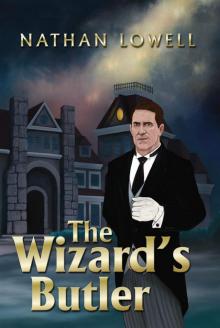 The Wizard's Butler
The Wizard's Butler Cape Grace
Cape Grace By Darkness Forged
By Darkness Forged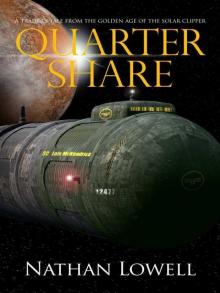 Quarter Share
Quarter Share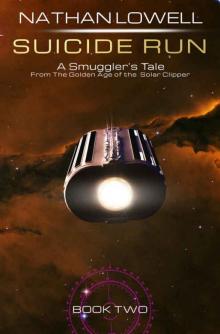 Suicide Run (Smuggler's Tales From the Golden Age of the Solar Clipper Book 2)
Suicide Run (Smuggler's Tales From the Golden Age of the Solar Clipper Book 2)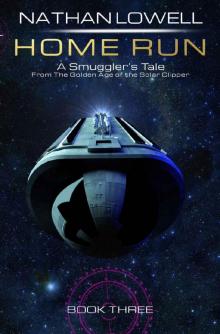 Home Run (Smuggler's Tales From the Golden Age of the Solar Clipper Book 3)
Home Run (Smuggler's Tales From the Golden Age of the Solar Clipper Book 3)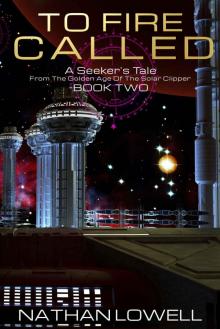 To Fire Called (A Seeker's Tale From The Golden Age Of The Solar Clipper Book 2)
To Fire Called (A Seeker's Tale From The Golden Age Of The Solar Clipper Book 2)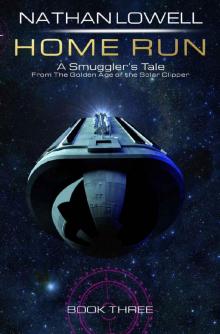 Home Run
Home Run Suicide Run
Suicide Run South Coast (Shaman's Tales From The Golden Age Of The Solar Clipper Book 1)
South Coast (Shaman's Tales From The Golden Age Of The Solar Clipper Book 1)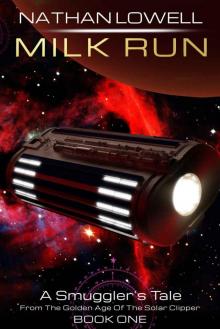 Milk Run (Smuggler's Tales From The Golden Age Of The Solar Clipper Book 1)
Milk Run (Smuggler's Tales From The Golden Age Of The Solar Clipper Book 1)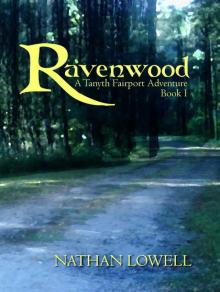 Ravenwood (Tanyth Fairport Adventures)
Ravenwood (Tanyth Fairport Adventures)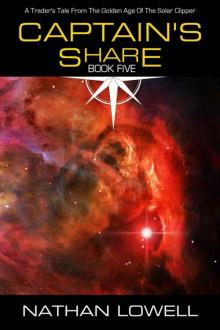 Captain's Share (Trader's Tales from the Golden Age of the Solar Clipper)
Captain's Share (Trader's Tales from the Golden Age of the Solar Clipper) Owner's Share (Trader's Tales from the Golden Age of the Solar Clipper)
Owner's Share (Trader's Tales from the Golden Age of the Solar Clipper) Half Share
Half Share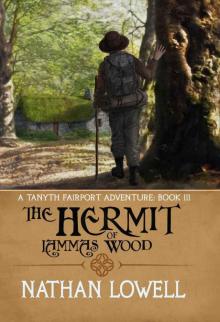 The Hermit of Lammas Wood
The Hermit of Lammas Wood Ravenwood
Ravenwood Full Share
Full Share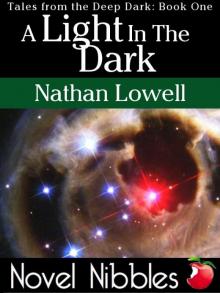 A Light In The Dark (Tales of the Deep Dark)
A Light In The Dark (Tales of the Deep Dark)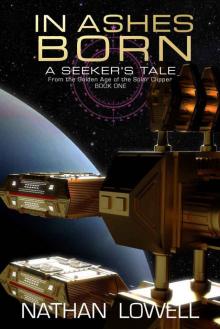 In Ashes Born (A Seeker's Tale From The Golden Age Of The Solar Clipper Book 1)
In Ashes Born (A Seeker's Tale From The Golden Age Of The Solar Clipper Book 1) Double Share: Solar Clipper Trader Tales
Double Share: Solar Clipper Trader Tales Zypheria's Call (A Tanyth Fairport Adventure)
Zypheria's Call (A Tanyth Fairport Adventure)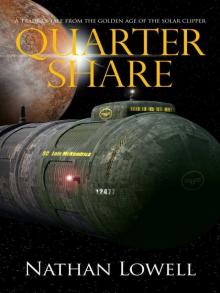 Quarter Share attftgaotsc-1
Quarter Share attftgaotsc-1